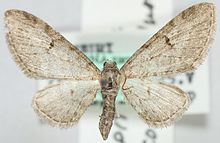Eupithecia quadripunctata
Appearance
(Redirected from Eupithecia abiecta)
| Eupithecia quadripunctata | |
|---|---|

| |
| Scientific classification | |
| Domain: | Eukaryota |
| Kingdom: | Animalia |
| Phylum: | Arthropoda |
| Class: | Insecta |
| Order: | Lepidoptera |
| Family: | Geometridae |
| Genus: | Eupithecia |
| Species: | E. quadripunctata
|
| Binomial name | |
| Eupithecia quadripunctata | |
| Synonyms | |
| |
Eupithecia quadripunctata is a moth in the family Geometridae. It is found in India, Pakistan, Nepal, Russia, China (Shanxi, Shaanxi, Gansu, Hebei, Henan, Heilongjiang),[2] Taiwan, Korea, Japan[3] and northern Thailand.[4]
The wingspan is about 15–25 millimetres (0.59–0.98 in). There are two generations per year. The aestival brood is much smaller than the vernal brood.[5]
References
[edit]Wikimedia Commons has media related to Eupithecia quadripunctata.
Wikispecies has information related to Eupithecia quadripunctata.
- ^ Yu, Dicky Sick Ki. "Eupithecia quadripunctata Warren 1888". Home of Ichneumonoidea. Taxapad. Archived from the original on March 25, 2016.
- ^ Beccaloni, G.; Scoble, M.; Kitching, I.; Simonsen, T.; Robinson, G.; Pitkin, B.; Hine, A.; Lyal, C., eds. (2003). "Eupithecia quadripunctata". The Global Lepidoptera Names Index. Natural History Museum.
- ^ Japanese Moths
- ^ Mironov, V.G. ; A.C. Galsworthy & K. Yazaki, 2009: A survey of the genus Eupithecia (Lepidoptera, Geometridae) in mainland South East Asia: Part II. Transactions of the Lepidopterological Society of Japan 60(3): 167-188. Abstract: [1]
- ^ "Taxonomic Review of the Genus Eupithecia (Lepidoptera : Geometridae : Larentiinae) from Korea (II)" (PDF). Archived from the original (PDF) on 2016-02-04. Retrieved 2013-04-04.
- Mironov, V.G. ,A.C. Galsworthy & U. Ratzel, 2008, A survey of the Eupithecia fauna (Lepidoptera: Geometridae) of the Western Himalayas: Part 2, Transactions of the Lepidopterological Society of Japan 59 (2): 117-143.
- Mironov, V.G. ; A.C. Galsworthy & K. Yazaki, 2009: A survey of the genus Eupithecia (Lepidoptera, Geometridae) in mainland South East Asia: Part II. Transactions of the Lepidopterological Society of Japan 60(3): 167-188. Abstract: [2].
